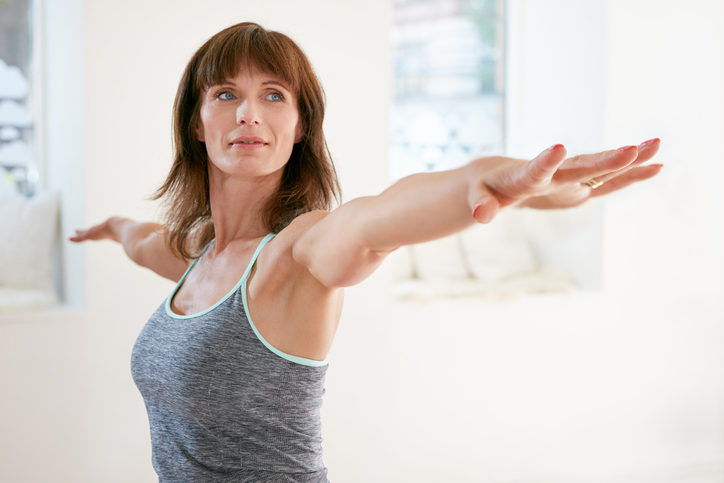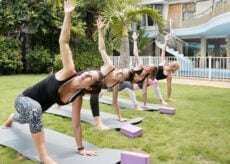Why Flexibility Exercises are SO Important As You Age

Are you the type of person who tends to leave stretching for the end of the workout? I know I am. After all, we can justify it because flexibility exercises seem to be most effective when the muscles are “warmed up.”
However, we all know what happens when even the best-laid plans are put off until the end—they seldom happen. Yes, I go into the gym with every intention of stretching “after my workout,” but then it turn into, “I’ll stretch when I get home.” That, of course, doesn’t happen, and the next thing you know, you’re feeling stiff, achy, and dare I say…old.
Well, maybe this overview covering the benefits of being flexible will help you make stretching a priority. As you incorporate flexibility exercises into your routine, you’ll be surprised how easy it is to keep your body supple, young, and limber.
What Is Flexibility?
What is flexibility and why is it so important, especially as you age? The dictionary explains “flexibility” as “the quality of bending easily without breaking, “the ability to be easily modified,” and “willingness to change and compromise.” From an anatomical standpoint, Wikipedia states, “Flexibility or limberness refers to the absolute range of movement in a joint or series of joints, and length in muscles that cross the joints to induce a bending movement or motion.”
Simply put, being flexible is important in all aspects of life.
Why Is It Necessary?
Despite its obvious significance, flexibility is often overlooked; however, it plays a crucial role in role in overall health, fitness, and function. Tight muscles can lead to aches and pains, poor posture, and difficulty performing simple tasks, such as household chores, getting out of bed, and playing with your kids or grandchildren.
Reduced flexibility can also lead to poor balance. While that’s typically a concern for older adults who are worried about the risk of falling, balance also plays a vital role in sports performance and injury prevention. Simply put, reduced mobility (a result of poor flexibility and decreased strength and muscle mass) can adversely affect daily activities, negatively impact quality of life, and limit you from doing what you love most.
Although joint flexibility decreases with age, the fortunate news is that flexibility can be improved across ALL age groups with proper flexibility training. In fact, range of motion can be improved with as little as 4 weeks of regular stretching 2 – 3 times per week.
In addition to increasing range of motion and functional capacity, flexibility exercises have been shown to improve posture, stability, and balance. While the research is somewhat mixed, some studies have shown that regular flexibility exercise can reduce the likelihood of injuries, prevent low back pain, and reduce muscle soreness.
Types of Flexibility Exercises
Static stretching can be “active” or “passive.” Active static stretching involves holding the stretched position by using the strength of the muscle(s) that work(s) in opposition (called the “antagonist”) to the one you’re stretching. Yoga is a good example of active static stretching. Passive static stretching is the most common form of stretching, and it involves assuming a stretched position while holding a limb or other part of the body with or without the assistance of a partner or other form of outside assistance (such as elastic bands or barre).
Dynamic, or slow movement, stretching involves a gradual transition from one body position to another. It involves a progressive increase in range of motion as the movement is repeated several times. Movements like arm circles, neck stretches, and side bends are all examples of dynamic stretching, which may help lengthen your muscles.
Ballistic, or “bouncing,” stretches use the momentum of the body to produce the stretch. Ballistic stretching, when properly performed, increases flexibility similarly to static stretching. That said, it is an advanced technique, and it may be more suitable for athletes and individuals involved in activities involving ballistic types of movements.
Get Your Stretch On!
Okay, you get it: Flexibility is important. So, how do you go about improving it? Great question.
According to the American College of Sports Medicine (ACSM), the largest sports medicine and exercise science organization in the world, there are several important variables to consider:
- Frequency: At least 2 – 3 days per week is effective for improving flexibility, and greater gains can be attained if performed more frequently.
- Type: A series of flexibility exercises for each of the major muscle groups is recommended.
- Intensity: Stretch to the point of feeling tightness or slight discomfort.
- Time: Holding a static stretch for 10 – 30 seconds is recommended for most adults; however, older adults may see greater benefits by holding a stretch for 30 – 60 seconds.
- Repetitions: Repetition of each flexibility exercise 2 – 4 times is recommended.
- Volume: A reasonable target is to perform 60 seconds of total stretching time for each of your flexibility exercises (e.g., two 30-second or four 15-second stretches).
- Timing: Flexibility training is most effective when the muscle is “warmed up” either actively (such as moderate aerobic activity) or passively (such as hot baths).
- When NOT to stretch: Stretching exercises can have a negative effect on muscle strength and power and sports performances. Having said that, flexibility training plus resistance training may result in even greater benefits in posture, stability, balance, and physical function.
What Benefits You Can Expect
Why is being flexible helpful in everyday life and what are the benefits of being flexible?
- More mobility and physical freedom
- Less stress
- Less injury prone
- Better posture
- Better balance
- Better mind-body connection
- Better performance
- Less soreness
Now You Try It
Flexibility is a fundamental component of a well-rounded fitness program, which should also include resistance, cardiovascular, and balance exercise training. In addition to the general guidelines provided above, one of my favorite ways to incorporate flexibility exercises is by practicing yoga.
As mentioned above, most forms of yoga incorporate active static stretching. In addition to the flexibility benefits, yoga is also great for improving balance and coordination, and it is excellent for stress management.
Now that you know the secret to youthfulness, don’t put flexibility training on the backburner any longer. Get your stretch on!
Supercharge Your Diet Results with IC-5
IC-5, which is scientifically-designed to promote insulin sensitivity and improved carb tolerance, is one of our top diet-boosting supplement.
With IC-5, you know that you are supporting carbohydrate tolerance, keeping potentially harmful AGEs at bay, and amplifying the anti-aging effects of the ketogenic diet. It’s a triple threat for overall health and anti-aging!







